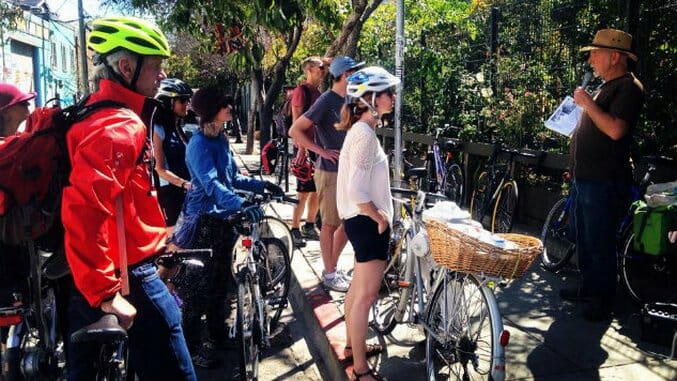San Francisco Food History, On Two Wheels
Photos by Dakota Kim
In rapidly reconstructed cities where the pavement is ofttimes as fresh as the food, it can be difficult to visualize the complex traces of history beneath our feet. Shaping San Francisco, an organization dedicated to preserving the history of the diverse city by the Bay, leads tours to bring these complex histories to life, and one such tour is the Food Politics History Tour.
But San Francisco can be a difficult city to quickly traverse, especially with a large group on foot, and bike riding a method of transport that guides Chris Carlsson and Lisaruth Elliott are well familiar with. Both are ardent cyclists — Carlsson is one of the co-founders of Critical Mass, and Elliott delivers bread with a bike trailer breadmobile for her slow food breaducation project called Lisaruth’s Lovin’ From the Oven.
San Francisco is a unique food city. It’s not that New York, my beloved city for almost 15 years, doesn’t stun with its history of oysters in the Gowanus, fresh catches at the Fulton Fish Market, doubles at the West Indian bakeries, and activists in the East New York and East Village community gardens. But New York is, in my opinion, more focused on commerce and more traditional in its food leanings, while what I have found in San Francisco in my year living there and during a recent two-week trip are a more innovative restaurant culture and a focus on cooperation, activism and radical thinking. The traditional capitalist models of trading time for money at work, and money for food at a grocery store, were subverted strongly in the sixties and seventies in San Francisco. The city’s radical food traditions laid strong roots that refuse to be entirely uprooted by the now rapidly-gentrifying city. Moreover, the bounty of farms surrounding the city provide fresher produce year-round than New York, and the opportunity for a vegetable-forward California cuisine.

We set out to discover the historical roots that laid the groundwork for this innovative, cooperative food scene with the wind and sun on our faces and slices of sweet, fresh heirloom tomato from a local farm in our stomachs. Carlsson and Elliott led us on two wheels across the expanse of eastern San Francisco, from the Embarcadero to the Mission, beginning at Shaping San Francisco’s headquarters at 518 Valencia. There, in the neighborhood where the first agricultural settlement in San Francisco was established, Carlsson gave us a short rundown of the abundant food histories of San Francisco.
“For thousands of years, people lived in dense communities, and food was easy to find,” Carlsson said. He then recounted a story about early San Francisco settler William Richardson, who built a house in 1835 that looked down upon the water. When he and his son were sitting on the veranda looking down on the beach and the tide had gone out, they saw massive salmon and sturgeon of seven to eight feet long flopping around on the beach. Then, they were amazed to see a coyote, a wolf and a bear begin fighting for the fish.
“When the cattle arrived, the grasses changed,” Carlsson said. And when fortune seekers came pouring in during the Gold Rush, people needed to eat. Carlsson told us about the history of Chinese fishermen who brought fish to the hungry masses, and eggers poached the delicious eggs of the California murre bird by the hundreds of thousands from the Farallones Islands. Carlsson discussed how Chinese immigrant food workers were thought to be taking jobs from Americans, so the Chinese Exclusion Act was passed, and then Japanese farmers came instead, who were banned from owning land. Filipino and Mexican workers followed.
Carlsson detailed to us how in 1943, Italian farmers had nowhere to ply their produce, including beautiful Marin County pears. Canneries were full due to war efforts and pears were rotting on the ground. That is, until farmers markets were established — the first brought 50,000 people on its first day.
Then our group of 15 or so got on our bikes and rode over the land that was once farms and marshes down to Howard and Langton to visit the Langton Community Garden, a large, sunny garden alive with gardeners and butterflies. There, we discussed the history of community gardens in San Francisco. The fascinating radical food history of San Francisco traces a line through many groups of gardening revolutionaries. The first community gardens in San Francisco were victory gardens started during the war to feed locals, and during the Gilded Age, food from the community gardens was given to the poor. The People’s Park), which grew out of sixties and seventies Berkeley protests, resulted in a community garden that was imitated across the nation. In 1981, the San Francisco League of Urban Gardeners was formed, which declared that San Francisco should have 100 gardens — and it accomplished its goal.

Elliott pointed out that community gardens are responsible for the thriving of birds and bees in the city. “The western tiger swallowtail thrives because of community gardens,” Elliott said.
-

-

-

-

-

-

-

-

-

-

-

-

-

-

-

-

-

-

-

-

-

-

-

-

-

-

-

-

-

-

-

-

-

-

-

-

-

-

-

-












































